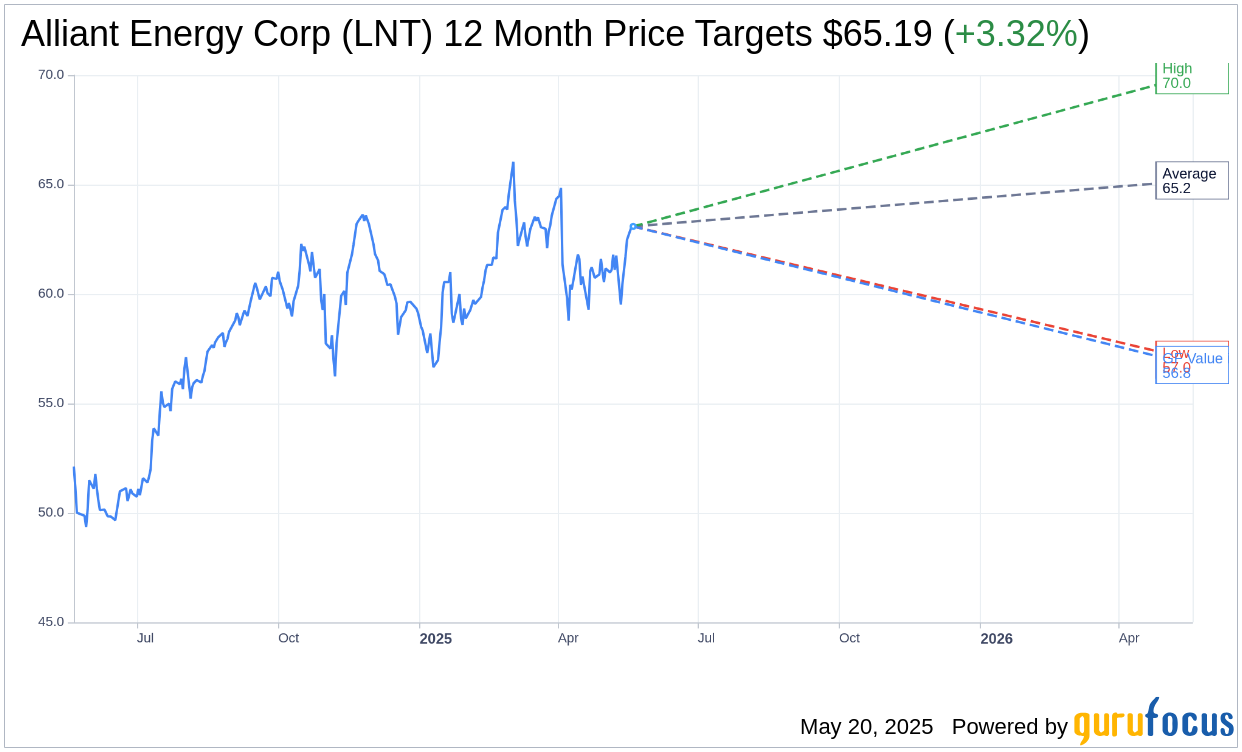Jefferies analyst Julien Dumoulin-Smith has raised his rating on Alliant Energy (LNT, Financial) from Hold to Buy, with an adjusted price target now set at $71, up from the previous $70. Recent uncertainties have impacted the stock, presenting a new opportunity for investors. The analyst highlights Alliant Energy's positive potential, with promising developments following a constructive first quarter and encouraging updates at the AGA conference.
Wall Street Analysts Forecast

Based on the one-year price targets offered by 11 analysts, the average target price for Alliant Energy Corp (LNT, Financial) is $65.19 with a high estimate of $70.00 and a low estimate of $57.00. The average target implies an upside of 3.32% from the current price of $63.09. More detailed estimate data can be found on the Alliant Energy Corp (LNT) Forecast page.
Based on the consensus recommendation from 14 brokerage firms, Alliant Energy Corp's (LNT, Financial) average brokerage recommendation is currently 2.6, indicating "Hold" status. The rating scale ranges from 1 to 5, where 1 signifies Strong Buy, and 5 denotes Sell.
Based on GuruFocus estimates, the estimated GF Value for Alliant Energy Corp (LNT, Financial) in one year is $56.76, suggesting a downside of 10.03% from the current price of $63.09. GF Value is GuruFocus' estimate of the fair value that the stock should be traded at. It is calculated based on the historical multiples the stock has traded at previously, as well as past business growth and the future estimates of the business' performance. More detailed data can be found on the Alliant Energy Corp (LNT) Summary page.
LNT Key Business Developments
Release Date: May 09, 2025
- Earnings Per Share (EPS): $0.83 for Q1 2025, compared to $0.62 for Q1 2024.
- 2025 Earnings Guidance: Reaffirmed at $3.15 to $3.25 per share.
- Capital Expenditure Plan: Increased by approximately $600 million from November 2024 update, totaling $11.5 billion for 2025-2028.
- Revenue Drivers: Higher revenue requirements from capital investments at IPL and WPL.
- Temperature Impact: Warmer than normal temperatures decreased electric and gas margins by $0.03 per share in Q1 2025.
- Customer Growth: Increased use per meter across all retail customer classes at Wisconsin utility.
- Financing Plan: Cash from operations and tax credit monetization make up almost 50% of financing; new debt financing accounts for approximately 40%; new common equity issuances account for approximately 12%.
- Safe Harbor Activities: Nearly all planned safe harbor activities completed for future energy storage and renewable projects through 2028.
For the complete transcript of the earnings call, please refer to the full earnings call transcript.
Positive Points
- Alliant Energy Corp (LNT, Financial) reported a strong start to 2025, achieving more than 25% of their earnings guidance midpoint in the first quarter.
- The company has executed energy supply agreements totaling 2.1 gigawatts of demand, representing a significant increase in peak demand.
- Alliant Energy Corp (LNT) has updated its capital expenditure plan, reflecting a nearly 26% increase from 18 months ago, with a forecasted investment CAGR of nearly 11% from 2024 to 2028.
- The company is well-positioned with safe harbor activities for renewable and energy storage projects, ensuring tax credit qualification through 2028.
- Alliant Energy Corp (LNT) reaffirmed its 2025 earnings guidance range of $3.15 to $3.25 per share, supported by strong financial performance and strategic initiatives.
Negative Points
- Warmer than normal temperatures in the first quarter of 2025 negatively impacted electric and gas margins by $0.03 per share.
- Higher depreciation and financing expenses partially offset the positive drivers of the company's financial performance.
- The company faces potential risks from legislative changes, such as the repeal or scaling back of the Inflation Reduction Act (IRA) and tax credits.
- Alliant Energy Corp (LNT) anticipates the need for $1.4 billion in new common equity issuances through 2028, which could impact shareholder value.
- The company is exposed to a 20% tariff on batteries sourced from China, although it remains the lowest cost option compared to domestically produced batteries.
